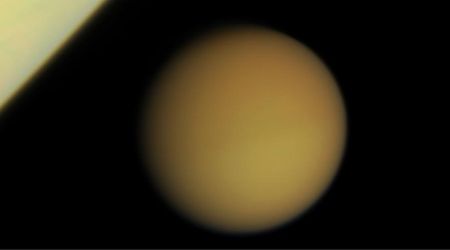How far away is Jupiter


How far away is The Jupiter now?
Last Updated: Today
Where does this live distance data come from?
I source Jupiter's distance from Earth via the Horizon JPL API. It is a free service provided by NASA's Jet Propulsion Laboratory (JPL) that offers access to ephemeris (positional) data and related information for celestial bodies, such as planets, asteroids, and comets. The system can be accessed through various interfaces, including a web interface, a telnet interface, and an email interface.
This API contains the precise distance between Jupiter and Earth from each day of the next few hundred years.
So I simply created a system to check for today's date, then go retrieve the accurate distance value directly from NASA's database. The up-to-date value is then displayed on this page.
How do scientists calculate the real-time distance between Jupiter and earth?
Scientists calculate the live distance between Jupiter and Earth using a combination of mathematics, astronomical data, and the principles of celestial mechanics. The positions of Earth and Jupiter in their respective orbits are constantly changing due to their elliptical orbits and different orbital periods around the Sun.
Jupiter's orbital parameters
Orbital parameters describe the way objects move around in space, such as planets, moons, and satellites. These parameters include the size, shape, and tilt of the orbit, as well as the object's position and speed within the orbit.
They help scientists understand and predict the paths of celestial bodies, which is crucial for planning space missions, observing astronomical phenomena, and monitoring satellites.
| Orbital Property | Explanation | Jupiter | Earth | Ratio (Jupiter/Earth) |
|---|---|---|---|---|
| Semimajor axis (10^6 km) | Average distance from the center of the orbit to the planet | 778.479 | 149.598 | 5.204 |
| Sidereal orbit period (days) | Time for one orbit around the Sun relative to fixed stars | 4,332.589 | 365.256 | 11.862 |
| Tropical orbit period (days) | Time for one orbit around the Sun relative to vernal equinox | 4,330.595 | 365.242 | 11.857 |
| Perihelion (10^6 km) | Closest distance to the Sun during the orbit | 740.595 | 147.095 | 5.035 |
| Aphelion (10^6 km) | Farthest distance to the Sun during the orbit | 816.363 | 152.100 | 5.367 |
| Synodic period (days) | Time to return to the same position relative to Earth and Sun | 398.88 | - | - |
| Mean orbital velocity (km/s) | Average speed of orbiting around the Sun | 13.06 | 29.78 | 0.439 |
| Max. orbital velocity (km/s) | Maximum speed during the orbit | 13.72 | 30.29 | 0.453 |
| Min. orbital velocity (km/s) | Minimum speed during the orbit | 12.44 | 29.29 | 0.425 |
| Orbit inclination (deg) | Angle between orbital plane and reference plane | 1.304 | 0.000 | - |
| Orbit eccentricity | Deviation of the orbit from a perfect circle | 0.0487 | 0.0167 | 2.916 |
| Sidereal rotation period (hrs) | Time for one complete rotation on its axis | 9.9250* | 23.9345 | 0.415 |
| Length of day (hrs) | Duration of one full day | 9.9259 | 24.0000 | 0.414 |
| Obliquity to orbit (deg) | Angle between planet's axis of rotation and orbital plane | 3.13 | 23.44 | 0.134 |
| Inclination of equator (deg) | Angle between planet's equator and its orbital plane | 3.13 | 23.44 | 0.134 |
Jupiter at opposition (list for the next 30 years)
When astronomer talks about Jupiter being at opposition, it means that Jupiter, Earth, and the Sun are aligned in a straight line, with Earth in the middle. During this time, which lasts for a few weeks, Jupiter appears brighter and larger in the sky because it's at its closest point to Earth in its orbit.
This planetary opposition approximately once every 13 months, or about once a year, providing astronomers and stargazers with an amazing opportunity to observe and admire the godfather planet of the solar system.
Below you can find a list of opposition dates for the next 30 years:
| Date & Hour | Distance to the Earth (miles) | Distance to the Earth (km) | Declination |
|---|---|---|---|
| 2023 Nov 03 05:02 | 369,966,255.2 | 594,764,508.3 | +13° 37' |
| 2024 Dec 07 20:57 | 400,066,116.6 | 643,755,757.9 | +22° 03' |
| 2026 Jan 10 08:41 | 431,904,591.7 | 694,685,771.8 | +22° 11' |
| 2027 Feb 11 00:28 | 461,040,894.2 | 741,386,942.2 | +15° 09' |
| 2028 Mar 12 15:36 | 478,717,446.7 | 770,396,281.8 | +04° 19' |
| 2029 Apr 12 04:04 | 479,103,046.7 | 770,984,317.6 | -07° 19' |
| 2030 May 13 11:32 | 461,267,164.8 | 742,318,167.1 | -17° 18' |
| 2031 Jun 15 09:19 | 427,231,392.4 | 687,983,645.6 | -22° 50' |
| 2032 Jul 19 08:33 | 388,721,215.4 | 625,478,855.1 | -21° 09' |
| 2033 Aug 25 05:39 | 359,348,938.3 | 578,676,118.3 | -11° 49' |
| 2034 Oct 02 00:57 | 348,774,574.6 | 561,358,939.7 | +02° 02' |
| 2035 Nov 08 05:41 | 359,869,489.7 | 579,446,504.9 | +15° 14' |
| 2036 Dec 12 14:41 | 389,395,705.9 | 626,701,748.5 | +22° 35' |
| 2038 Jan 14 19:57 | 427,235,604.2 | 687,986,364.3 | +21° 33' |
| 2039 Feb 15 08:01 | 456,949,018.6 | 735,911,668.9 | +13° 45' |
| 2040 Mar 16 21:57 | 478,136,315.7 | 769,815,901.4 | +02° 38' |
| 2041 Apr 16 12:20 | 478,188,946.5 | 769,899,477.6 | -08° 55' |
| 2042 May 17 23:53 | 456,196,013.2 | 734,733,133.2 | -18° 27' |
| 2043 Jun 20 02:35 | 427,430,040.8 | 688,134,158.1 | -23° 05' |
| 2044 Jul 24 06:54 | 390,457,478.6 | 628,041,274.3 | -20° 16' |
| 2045 Aug 30 07:01 | 359,893,292.2 | 579,563,304.7 | -10° 04' |
| 2046 Oct 07 01:28 | 349,121,681.9 | 561,901,072.2 | +04° 00' |
| 2047 Nov 13 02:10 | 360,323,508.8 | 579,878,514.5 | +16° 41' |
| 2048 Dec 17 05:31 | 389,525,311.5 | 626,907,559.4 | +22° 57' |
| 2050 Jan 19 05:56 | 427,288,908.4 | 688,268,739.3 | +20° 46' |
| 2051 Feb 19 14:39 | 455,891,589.9 | 734,420,078.1 | +12° 17' |
| 2052 Mar 21 03:57 | 477,498,446.8 | 768,941,117.8 | +00° 56' |
| 2053 Apr 20 19:40 | 478,020,082.7 | 769,662,683.7 | -10° 28' |
Just for fun, how long would it take to reach Jupiter via different transportation means
The average distance between Earth and Jupiter is 484 million miles (778 million km), so based on that distance, I have calculated the time it would take to reach the gas giant planet at the speed of different means of transportation.
- On foot (3 mph): approximately 18,411 years
- Bicycle (15 mph): approximately 3,660 years
- Horse (galloping at 25 mph): approximately 2,196 years
- Motorbike (average speed of 70 mph): approximately 789 years
- Boat (cruising speed of 20 knots which equals 23 mph): approximately 2,374 years
- Car (60 mph): approximately 877 years
- High-speed train (322 km/h equals 200 mph): approximately 262 years
- Commercial Airplane (575 mph): approximately 95 years
- Concorde supersonic jet (1,350 mph): approximately 41 years
- SpaceX Starship (projected average speed of 16,777 mph): approximately 0.32 years (or approximately 4 months).
Please note this is only for fun and it does not reflect the reality of space travel. This is a simplification and does not account for acceleration, deceleration, or the gravitational influences of celestial bodies which would play significant roles in actual space travel.
Also, these calculations assume constant speed, which is not how actual space travel works. A real trip to Jupiter would be faster due to the spacecraft picking up speed from gravitational assists.
Bonus Fact: On average it takes about 35-52 minutes (depending on the positions of Jupiter and Earth in their respective orbits) for light from Jupiter to reach Earth.
How far away are the other planets of the solar system?
I have developed a webpage that monitors the real-time distances between Earth and each planet of the solar system (work in progress):
- Real-time distance between the Moon and Earth
- Real-time distance between Mercury and Earth
- Real-time distance between Mars and Earth
- Real-time distance between Venus and Earth
- Real-time distance between Saturn and Earth
- Real-time distance between Uranus and Earth
- Real-time distance between Neptune and Earth
- How far away is Earth from the Sun









